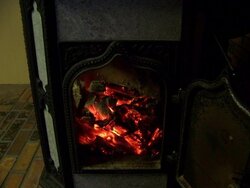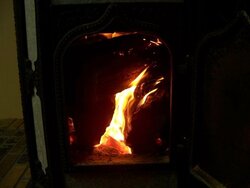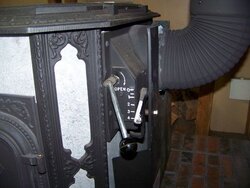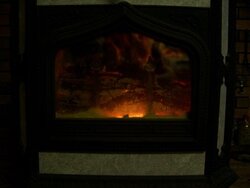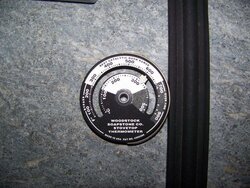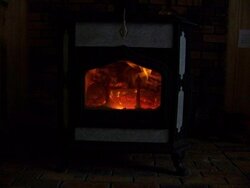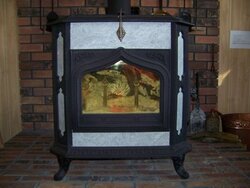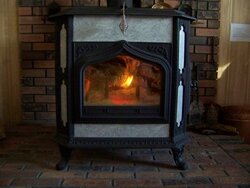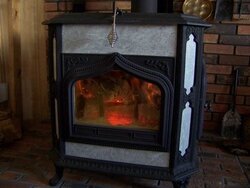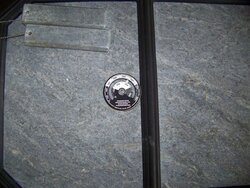I know you guys and gals love pictures so I thought I'd post a few and discribe how I get the most heat from my stove. First couple pics are the coal bed this morning after a 10+ hour burn last night. Stove top was a tad over 200, opened bypass, raked coals forward, turned air up to #2, loaded 2 splits of Black Locust E/W, and 2 more shorties N/S.
Burning My Fireview
- Thread starter Todd
- Start date
-
Active since 1995, Hearth.com is THE place on the internet for free information and advice about wood stoves, pellet stoves and other energy saving equipment.
We strive to provide opinions, articles, discussions and history related to Hearth Products and in a more general sense, energy issues.
We promote the EFFICIENT, RESPONSIBLE, CLEAN and SAFE use of all fuels, whether renewable or fossil.
You are using an out of date browser. It may not display this or other websites correctly.
You should upgrade or use an alternative browser.
You should upgrade or use an alternative browser.
- Status
- Not open for further replies.
I engaged a tad over #1 after 15 minutes in bypass mode for this load and let her burn for about 45 minutes til the stove hit 600, then turned it down to about .8. Here's a pic of my painted air settings which make it easier to read in dim lighting and another pic of 5 minutes after engaging the cat.
Attachments
She's pumping out the heat, climbed up to about 650 after I turned it down to .8, then slowely dropped down to 550 where it's holding now. This is what my fire looks like at .8 at 600 degree stove top. The pics aren't the best and I have a hard time sizing them without getting an error message, I wish it was easier to post pics here like other sites.
Attachments
Fsappo
Minister of Fire
Thanks for the pics. Good idea painting the heat settings. I would post a lot of photos from stoves working in our showroom under different conditions if it didnt require an act of congress to do so
akennyd
Member
THANKS FOR THE POSTING AND THE PICS !
!
I'm wanting mine in so bad I can't stand it but it won't be happening until our house addition is finished.
Forecast to be down in the 20's at night for about a week around here (don't laugh, that's cool for us). ARRGGGGHHHHHH !
!
Kenny
John 3:16
 !
!I'm wanting mine in so bad I can't stand it but it won't be happening until our house addition is finished.
Forecast to be down in the 20's at night for about a week around here (don't laugh, that's cool for us). ARRGGGGHHHHHH
 !
!Kenny
John 3:16
Some more pictures. I'm leaving the air at .8 and that should give me a good 8 hour burn with a similar coal bed as previous picture. Then I will pack it full before I go out and celebrate New Years Eve.
Attachments
Backwoods Savage
Minister of Fire
Looks pretty typical Todd. Good pictures and thanks for posting them. You are right about the painting on the numbers. I may have to give that a try.
On the boot driers, we just took the chains off ours as we can see no need for them. Also, no worry about that chain scratching the surface of the stone.
On the boot driers, we just took the chains off ours as we can see no need for them. Also, no worry about that chain scratching the surface of the stone.
Backwoods Savage said:Looks pretty typical Todd. Good pictures and thanks for posting them. You are right about the painting on the numbers. I may have to give that a try.
On the boot driers, we just took the chains off ours as we can see no need for them. Also, no worry about that chain scratching the surface of the stone.
I never thought about taking the chains off, DUH! I don't use them much anyways.
apples439
New Member
Todd - Great idea regarding the painted numbers. So simple yet so functional. Thanks.
I'm having a bit of trouble getting my stove to stay up to temperature for any reasonable amount of time. This is my first year burning so I'm riding the learning curve. I fill the box and let it heat up to 400 or so. Then I engage the cat and turn it down to 1. It goes up a bit...500ish but then goes back down to 400 where the decline slows as it makes it's way down to 300-350. If I adjust the draft downwards, say to .8, 15 minutes after engaging the cat, the temp will drop fairly rapidly.
I've got two suspicions and maybe you can help confirm or debunk them. The first is the wood. Needs more time. I see this so often that I can't help but think I am making this common mistake. My wood (mostly oak) is seasoned. It's not perfect, but I would estimate it at about 22%...maybe slightly higher. This figure is coming from a cheap moisture meter I borrowed from a neighbor so its results have to be taken with a grain of salt. However, comparable pieces of less seasoned wood are much heaver, less end-cracks, etc.
The second suspicion is my technique. Am I not letting the initial fire get hot enough before engaging the cat? You are burning different (and probably dryer) wood than I am, but how long does it usually take your FV to get to 600 or so at a draft setting of 2 before you engage the cat?
Thanks again for the great tip (as well as all the other posts I have learned from).
-Another Todd
I'm having a bit of trouble getting my stove to stay up to temperature for any reasonable amount of time. This is my first year burning so I'm riding the learning curve. I fill the box and let it heat up to 400 or so. Then I engage the cat and turn it down to 1. It goes up a bit...500ish but then goes back down to 400 where the decline slows as it makes it's way down to 300-350. If I adjust the draft downwards, say to .8, 15 minutes after engaging the cat, the temp will drop fairly rapidly.
I've got two suspicions and maybe you can help confirm or debunk them. The first is the wood. Needs more time. I see this so often that I can't help but think I am making this common mistake. My wood (mostly oak) is seasoned. It's not perfect, but I would estimate it at about 22%...maybe slightly higher. This figure is coming from a cheap moisture meter I borrowed from a neighbor so its results have to be taken with a grain of salt. However, comparable pieces of less seasoned wood are much heaver, less end-cracks, etc.
The second suspicion is my technique. Am I not letting the initial fire get hot enough before engaging the cat? You are burning different (and probably dryer) wood than I am, but how long does it usually take your FV to get to 600 or so at a draft setting of 2 before you engage the cat?
Thanks again for the great tip (as well as all the other posts I have learned from).
-Another Todd
Ted E. Bear said:Todd - Great idea regarding the painted numbers. So simple yet so functional. Thanks.
I'm having a bit of trouble getting my stove to stay up to temperature for any reasonable amount of time. This is my first year burning so I'm riding the learning curve. I fill the box and let it heat up to 400 or so. Then I engage the cat and turn it down to 1. It goes up a bit...500ish but then goes back down to 400 where the decline slows as it makes it's way down to 300-350. If I adjust the draft downwards, say to .8, 15 minutes after engaging the cat, the temp will drop fairly rapidly.
I've got two suspicions and maybe you can help confirm or debunk them. The first is the wood. Needs more time. I see this so often that I can't help but think I am making this common mistake. My wood (mostly oak) is seasoned. It's not perfect, but I would estimate it at about 22%...maybe slightly higher. This figure is coming from a cheap moisture meter I borrowed from a neighbor so its results have to be taken with a grain of salt. However, comparable pieces of less seasoned wood are much heaver, less end-cracks, etc.
The second suspicion is my technique. Am I not letting the initial fire get hot enough before engaging the cat? You are burning different (and probably dryer) wood than I am, but how long does it usually take your FV to get to 600 or so at a draft setting of 2 before you engage the cat?
Thanks again for the great tip (as well as all the other posts I have learned from).
-Another Todd
Sounds like your wood could be a little better. Are those moisture readings from the middle of a fresh split piece? Why are you waiting til 400 to engage the cat? 250 stove top is all you need, maybe your waiting too long and sending too much fuel up the chimney before the cat gets a chance to do it's thing?
When I reload with a full load I'll set the air at 2 til it gets going, then turn it down to about 1 and wait about 10 minutes before engaging. I leave the air at 1 and the stove will climb up to as high as 700 in 30-45 minutes but usually around 600 and slowly drop but hold above 500 for 3-4 hours. After 8 hours the stove top will be around 250 and ready for reload.
I'm burning 2-3 year old Black Locust at 17-20%.
If you are talking about a 400 degree stove top, I agree with Todd, you are waiting WAY too long. Once you are down to mostly coals there is very little for the cat to do so you aren't going to see high stove top temps. Plus, as Todd said, you have sent a good portion of your heat up the flue.
Backwoods Savage
Minister of Fire
Hello Ted. Glad you are still hanging around. I may as well kick in too and say that 400 degree was the first thing that caught my eye. If you are waiting that long then you are taking away some of the work that the cat should do and when the cat works the stovetop temperature goes up quite fast. Waiting to 400 also means most of the smoke is gone and that is what the cat needs to light.
When we reload, we set the draft full open. If the stove top is over 250 and we get a good fire then we'll engage the cat after 10 minutes but sometimes it takes a little longer. Just so long as the wood is good and charred. We have taken to setting the draft at 1 when engaging the cat but only leave it there for a short time before dialing it down further. How far down one dials it depends upon your individual setup. We get by nicely with about .25 while others go .5 or higher.
Give that a try, that is, engaging the cat sooner. I'm not even sure you could get to 600 without engaging the cat! Let us know how you do.
Good luck.
When we reload, we set the draft full open. If the stove top is over 250 and we get a good fire then we'll engage the cat after 10 minutes but sometimes it takes a little longer. Just so long as the wood is good and charred. We have taken to setting the draft at 1 when engaging the cat but only leave it there for a short time before dialing it down further. How far down one dials it depends upon your individual setup. We get by nicely with about .25 while others go .5 or higher.
Give that a try, that is, engaging the cat sooner. I'm not even sure you could get to 600 without engaging the cat! Let us know how you do.
Good luck.
apples439
New Member
Todd/Wendell/Dennis, thanks for the replies. I really appreciate it. Todd, yes those readings are from the center of freshly split pieces. I just spilt about 10 more larger pieces and my first estimate was a bit high. I'd say the average hovers closer to 18-20 (not that 2% would make all the difference in the world). I've got wood stacked and seasoning for next year (and the year after) but like every eager newbie, I wanted to start burning this year so I've got to deal with what I've got. I don't put much stock in those meters but it's fun to have an excuse to swing an axe. Now if I can only think of a reason to break the chainsaw out of hibernation! Ice sculpting?  My guess is that my wood is part of the problem, but it sounds like my technique leaves a lot to be desired. I knew I was doing something wrong. I'll try engaging the cat much sooner (250ish) with a draft of 1 and report back.
My guess is that my wood is part of the problem, but it sounds like my technique leaves a lot to be desired. I knew I was doing something wrong. I'll try engaging the cat much sooner (250ish) with a draft of 1 and report back.
Dennis, nice to hear from you again. What does your fire look like when you've got the draft set at .25? Just curious.
Thanks again, guys.
 My guess is that my wood is part of the problem, but it sounds like my technique leaves a lot to be desired. I knew I was doing something wrong. I'll try engaging the cat much sooner (250ish) with a draft of 1 and report back.
My guess is that my wood is part of the problem, but it sounds like my technique leaves a lot to be desired. I knew I was doing something wrong. I'll try engaging the cat much sooner (250ish) with a draft of 1 and report back. Dennis, nice to hear from you again. What does your fire look like when you've got the draft set at .25? Just curious.
Thanks again, guys.
Backwoods Savage
Minister of Fire
Ted, the fire will vary from nothing up to looking like the pits of Hell itself. If the flame disappears, it will later appear again with that rolling flame at the very top of the firebox. Most times when I go down to .25 the flame will increase for a bit and then calm down. How much flame you will get at that setting I am sure will depend entirely upon how dry the wood is.
Last night I tried an experiment. I loaded the stove with one piece of soft maple and then filled it with ash that I cut last winter and split last spring. After engaging the cat I turned it to 1 and left it for about an hour before dialing it down to .5. I thought I could leave it at .5 but it quickly went to 600 so I dropped it to .25 and it then held steady at 600. I went to bed and left it at .25. I got up early (like around 4:00 am) and checked on the stove. There were a mess of coals. Being so cold outdoors, I decided to put a few more splits in and ended up adding 4 small splits. Because it took off so quickly, I waited 5 minutes and the flue was at 500 with the stovetop at 450. I flipped the cat on, set it back to .25 and went back to bed. My wife added some wood sometime, I think, around 10:00. It warmed up to high 20's today so we didn't have much of a fire this afternoon but it is cooling fast now.
Good luck Ted.
Last night I tried an experiment. I loaded the stove with one piece of soft maple and then filled it with ash that I cut last winter and split last spring. After engaging the cat I turned it to 1 and left it for about an hour before dialing it down to .5. I thought I could leave it at .5 but it quickly went to 600 so I dropped it to .25 and it then held steady at 600. I went to bed and left it at .25. I got up early (like around 4:00 am) and checked on the stove. There were a mess of coals. Being so cold outdoors, I decided to put a few more splits in and ended up adding 4 small splits. Because it took off so quickly, I waited 5 minutes and the flue was at 500 with the stovetop at 450. I flipped the cat on, set it back to .25 and went back to bed. My wife added some wood sometime, I think, around 10:00. It warmed up to high 20's today so we didn't have much of a fire this afternoon but it is cooling fast now.
Good luck Ted.
apples439
New Member
Interesting. It has to be my wood. This afternoon, I filled the firebox and waited about 15 minutes. The stove-top was just a hair over 250. The draft was at 2 at this point. I then engaged the cat and dialed the draft down to 1. The stove-top climbed to 500 in about 40 minutes or so, but then started its decline back down to 300. All in all, the process took 2.5 hours or so. This has been my typical experience.
I'll try reducing the draft as it peaks at 500 or so and see what happens.
Thanks again.
I'll try reducing the draft as it peaks at 500 or so and see what happens.
Thanks again.
jdinspector
Feeling the Heat
Ted E., my experience is similar to yours. I can get 600 stove top temps if I really let it rip, but when I cut down the air, it drops to 400-450 and then holds there. I'm also still having a bit of a coaling problem. This happens only when I'm trying to really get it cranking. I am going to try to cut the air way down like others have done. It just occurred to me that cutting down the air slows the draft down, hence air/smoke/heat is moving slower through the stove. I assume that lets more heat get to the stove and then into my house. I am using considerably less fuel than my old Vermont Castings Stove, so that's a plus. My wood should be dry. I haven't taken a reading with my meter in a while, maybe this week when I move wood to the porch. It is a bit of a learning curve with the Fireview. I'm confident that it will work out though.
Todd, what a great idea on painting the numbers on the stove! I'll do that next time I let the stove cool down (maybe in March?!)
Todd, what a great idea on painting the numbers on the stove! I'll do that next time I let the stove cool down (maybe in March?!)
Ted E. Bear said:Interesting. It has to be my wood. This afternoon, I filled the firebox and waited about 15 minutes. The stove-top was just a hair over 250. The draft was at 2 at this point. I then engaged the cat and dialed the draft down to 1. The stove-top climbed to 500 in about 40 minutes or so, but then started its decline back down to 300. All in all, the process took 2.5 hours or so. This has been my typical experience.
I'll try reducing the draft as it peaks at 500 or so and see what happens.
Thanks again.
I think you need more air not less especially if you think your wood is less than optimum. Maybe try engaging at 1.25 and just leave it unless it looks like it will overfire. What does your coal bed look like at reload?
I have found the denser woods like Oak and especially Locust takes more air to get going and burn down completely. The lesser hardwoods like Ash, Elm, and Soft Maple take off fast and can be turned down much more.
Too bad WS didn't come out with a thermostatic air control like Blaze King, it's a really good option for a more even thorough burn.
apples439
New Member
I'll try setting it at 1.25 tonight. I've tried that before but I can't recall the outcome.
My coal bed after a long burn looks pretty decent. Little bit up front...nothing too substantial. Good amount in the back. I rake everything to the front in the morning and open the draft to 4/5 to let it burn down. I'd say the pile is probably 4-6 inches high and 3-4 inches deep running the length of the stove. This is if I set my draft to 1 the night before. If I set my draft to 1+, I get much less, obviously.
Interesting point about the wood density. It makes a lot of sense. Most of my wood is red oak so I'll keep it in mind as I keep experimenting with the draft. I'm just a bit disappointed that I can't get this beauty to heat up as much as I was expecting. Our house is a traditional cape with 1,800 square feet, new windows and well insulated. The temperature in the house should be higher than 65. I know it is not the stove or the draft that is to blame so that only leaves two variables...the wood and/or the operator. It can't be me as I tell my wife that I know what the hell I'm doing on a daily basis. Ahh, if she ever saw what stupidity I was posting here!
Thanks again.
My coal bed after a long burn looks pretty decent. Little bit up front...nothing too substantial. Good amount in the back. I rake everything to the front in the morning and open the draft to 4/5 to let it burn down. I'd say the pile is probably 4-6 inches high and 3-4 inches deep running the length of the stove. This is if I set my draft to 1 the night before. If I set my draft to 1+, I get much less, obviously.
Interesting point about the wood density. It makes a lot of sense. Most of my wood is red oak so I'll keep it in mind as I keep experimenting with the draft. I'm just a bit disappointed that I can't get this beauty to heat up as much as I was expecting. Our house is a traditional cape with 1,800 square feet, new windows and well insulated. The temperature in the house should be higher than 65. I know it is not the stove or the draft that is to blame so that only leaves two variables...the wood and/or the operator. It can't be me as I tell my wife that I know what the hell I'm doing on a daily basis. Ahh, if she ever saw what stupidity I was posting here!

Thanks again.
Sounds like a pretty deep coal bed to me. I think you can burn a little hotter. Keep experimenting with different loads and air settings, you will find the sweet spot.
apples439
New Member
Firstly, my house is a lot warmer today than it was yesterday thanks to you guys. The 1.25 draft did the trick to some extent. I'm able to get the temp up to 575 (maximum to date). It'll burn for about 5 hours slowly descending down to around 350. Is this typical? 10 hours or so and I'll have very few coals. Much fewer than before but still sufficient.
Todd (or anyone), is flu temp a consideration here? I don't have a probe thermometer like you but I have another Woodstock thermometer placed about 1 foot back on the horizontal pipe out the back of my stove (the pipe goes another foot or so then takes a 90 degree bend up 25 feet of insulated SS liner within an exterior chimney). For example, if I've got a 550 stove top temperature, but my flue temp (with my configuration) is at 450, am I losing some efficiency here by letting too much heat up the chimney? I will continue to play around with slight adjustments on the draft until I hit the sweet spot but I was just curious about the flu/stove relationship. I hope that makes sense.
I saved the dumbest question for last...what do you mean by different loads?
Todd (or anyone), is flu temp a consideration here? I don't have a probe thermometer like you but I have another Woodstock thermometer placed about 1 foot back on the horizontal pipe out the back of my stove (the pipe goes another foot or so then takes a 90 degree bend up 25 feet of insulated SS liner within an exterior chimney). For example, if I've got a 550 stove top temperature, but my flue temp (with my configuration) is at 450, am I losing some efficiency here by letting too much heat up the chimney? I will continue to play around with slight adjustments on the draft until I hit the sweet spot but I was just curious about the flu/stove relationship. I hope that makes sense.
I saved the dumbest question for last...what do you mean by different loads?
Backwoods Savage
Minister of Fire
Ted, it appears we have the same type of installation. 450 degree flue temperature here (we go up to 500 mostly) is reached only on reloads. After the cat kicks in the flue temperature typically drops to about 350 and slowly goes down from there. It will be anywhere from 200-300 degrees when we reload. So it does sound like you may be losing some heat up the chimney but then again, your wood might require that you have to do it.
I will state that when we set the draft open farther that we don't seem to get more heat from the stove at all but the wood burns up faster. We've tried different settings when the weather is really cold and still have found that the lower settings for us still produce more heat and the fire lasts longer. And we also turn up the draft maybe 1/2-1 hour before it is down to just coals; then we open the draft full.
Methinks what Todd was referring to with different loads is a combination of different woods, different amounts of wood, etc.
I will state that when we set the draft open farther that we don't seem to get more heat from the stove at all but the wood burns up faster. We've tried different settings when the weather is really cold and still have found that the lower settings for us still produce more heat and the fire lasts longer. And we also turn up the draft maybe 1/2-1 hour before it is down to just coals; then we open the draft full.
Methinks what Todd was referring to with different loads is a combination of different woods, different amounts of wood, etc.
apples439
New Member
Dennis, I think you hit the nail on the head when you said my wood might require me to let some of that heat up the flu. I assume that this is due to it's slightly higher than desirable moisture content although, to Todd's point, the density of the wood obviously plays an important role. If I turn the draft down below 1, the temp drops steeply. I would assum that this is due to, in part, to the energy needed to burn off the excessive moisture as well as keep that dense wood a-burnin'.
Your comments regarding opening the draft up ring true in my experience too. Strange. It's counterintuitive to think that adding more air does nothing to heat the stove. I've noticed my flu temp will rise, however, which makes sense.
My wood supply is limited almost exclusively to oak (mostly red oak), but I can certainly try different quantities. I'll master this beast eventually, but I'm chalking this year up to education.
Your comments regarding opening the draft up ring true in my experience too. Strange. It's counterintuitive to think that adding more air does nothing to heat the stove. I've noticed my flu temp will rise, however, which makes sense.
My wood supply is limited almost exclusively to oak (mostly red oak), but I can certainly try different quantities. I'll master this beast eventually, but I'm chalking this year up to education.
Keep playing with it, maybe next time try between 1 and 1.25. Flue temps do tell another story but I can't say with a different set up than you. Does that horizontal pipe run have a slight rise going away from the stove? What does your fire look like when you turn it down to #1, Do the coals start to go dark or is the red still in them? The air setting on this stove is very sensitive and a very small adjustment can make a big difference. For a low burn I turn my air down slowly til the coals turn dark red with little flame, usually a smidge above .5, if I go lower everything turns black. If I want more heat I turn it up. Maybe my .5 is your #1 and Dennis's .25? After some trial and error you will figure it all out.
It would be nice to see Woodstock come out with a user video, it's kind of hard to explain and learn burning techniques without seeing fire.
It would be nice to see Woodstock come out with a user video, it's kind of hard to explain and learn burning techniques without seeing fire.
apples439
New Member
- Status
- Not open for further replies.
Similar threads
- Replies
- 11
- Views
- 1K
- Replies
- 22
- Views
- 1K
- Replies
- 0
- Views
- 436


